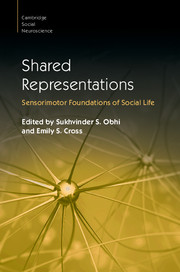Book contents
- Shared Representations
- Cambridge Social Neuroscience
- Shared Representations
- Copyright page
- Contents
- Figures
- Tables
- Boxes
- Contributors
- Preface
- Part I Foundations
- Part II Imitation and Mimicry
- Part III Thinking, Perceiving and Acting with Others
- Part IV Understanding Others
- Part V Learning and Development
- 21 Shared Interoceptive Representations
- 22 Mirror Neuron Formation via Associative Learning
- 23 Disorders of Shared Representations
- 24 Learning by Diffusion
- 25 Observational Motor Learning
- 26 The Impact of Action Expertise on Shared Representations
- Part VI Shared Representations in Applied Contexts
- Index
- Plate Section (PDF Only)
- References
26 - The Impact of Action Expertise on Shared Representations
from Part V - Learning and Development
Published online by Cambridge University Press: 27 October 2016
- Shared Representations
- Cambridge Social Neuroscience
- Shared Representations
- Copyright page
- Contents
- Figures
- Tables
- Boxes
- Contributors
- Preface
- Part I Foundations
- Part II Imitation and Mimicry
- Part III Thinking, Perceiving and Acting with Others
- Part IV Understanding Others
- Part V Learning and Development
- 21 Shared Interoceptive Representations
- 22 Mirror Neuron Formation via Associative Learning
- 23 Disorders of Shared Representations
- 24 Learning by Diffusion
- 25 Observational Motor Learning
- 26 The Impact of Action Expertise on Shared Representations
- Part VI Shared Representations in Applied Contexts
- Index
- Plate Section (PDF Only)
- References
Summary
Expertise in the motor domain is something we recognize almost instantaneously in other people, whether a gymnast performing a double layout with a twist, a basketball player slam dunking the ball, a Super-G skier descending a steep course at 80 mph, or a dancer executing 11 consecutive spins on one leg without stopping. While we might be able to readily recognize expertise in others, the degree to which action experts can coordinate or move their bodies in profoundly different ways to non-experts raises intriguing questions for those interested in shared representations between self and other in our social world. Namely, how does an observer’s ability to embody an action impact how she perceives that action, and how might perception change as further experience with the observed action is acquired? In this chapter, we address these questions by considering empirical research that explores the relationship between an actor and an observer’s motor abilities, and how expertise impacts this relationship.
- Type
- Chapter
- Information
- Shared RepresentationsSensorimotor Foundations of Social Life, pp. 541 - 562Publisher: Cambridge University PressPrint publication year: 2016
References
- 1
- Cited by



